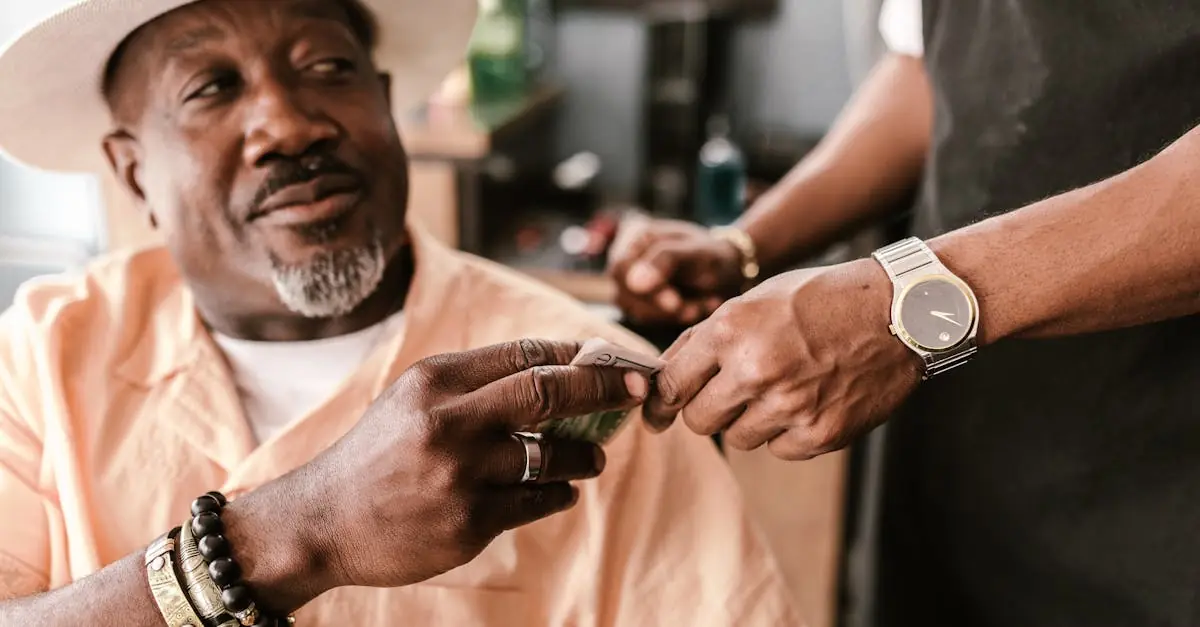In the world of fashion, the age-old debate between old money and new money never fails to spark interest. Picture this: a classic tweed blazer paired with tailored trousers versus a flashy designer logo splashed across a hoodie. It’s a clash of elegance and extravagance, where the subtlety of heritage meets the boldness of modern wealth.
Old money fashion whispers sophistication, while new money shouts for attention. One group sips tea at exclusive galas, while the other throws lavish parties with Instagram-worthy moments. But which style truly reigns supreme? As they navigate the ever-evolving landscape of trends, one thing’s for sure: both camps have their unique flair that keeps the fashion world buzzing. Buckle up as we dive into the fascinating nuances of old money versus new money fashion—because who doesn’t love a good style showdown?
Table of Contents
ToggleOld Money Vs New Money Fashion: An Overview
Old money fashion exudes timeless elegance and refinement. Traditional garments form the foundation of this style, showcasing quality over flamboyance. Well-tailored suits, classic trench coats, and luxury fabrics like cashmere and silk contribute to an enduring aesthetic. Designers such as Ralph Lauren and Burberry embody these principles, focusing on heritage and craftsmanship.
In contrast, new money fashion embraces a contemporary and often ostentatious approach. Bright colors, bold patterns, and prominent logos dominate their clothing choices. Enthusiasts of this style often prefer high-end streetwear brands like Off-White and Balenciaga, which celebrate inventiveness and trendsetting. Jewelry and accessories play a significant role, with oversized statement pieces and luxury items that generate attention.
Cultural influences shape these fashion styles significantly. Old money adherents often prioritize discreet luxury, subtly showcasing wealth without overt displays. New money, however, frequently adopts a more expressive approach, emphasizing status through visual impact. Social media, particularly platforms like Instagram, amplifies this trend, allowing new money wearers to broadcast their style to a wider audience.
Financial backgrounds also inform these contrasting aesthetics. Old money typically reflects generations of wealth and privilege, appreciating classic styles that withstand the test of time. Meanwhile, new money often stems from recent financial gains, leading to a desire for immediate recognition and validation through fashion choices.
Both fashion genres now influence current trends, as elements from each blend in today’s marketplace. Understanding the nuances between old money and new money fashion fosters a comprehensive view of contemporary style dynamics. Keep in mind that these distinctions continue to evolve, impacting how society perceives and adapts to fashion.
Key Characteristics of Old Money Fashion
Old money fashion exudes sophistication and discretion. Its hallmark traits reflect a commitment to timelessness.
Timeless Elegance
Timeless elegance defines the essence of old money fashion. Classic items like tailored suits, cashmere sweaters, and tailored trousers embody this aesthetic. Designers such as Ralph Lauren and Burberry create collections that transcend trends. Fabrics like silk and tweed add a luxurious touch, enhancing the overall look. Patterns remain subtle, with plaids and stripes often used sparingly. Jewelry tends to be understated, with pieces that convey heritage rather than extravagance. A refined color palette featuring neutrals and earth tones prevails, ensuring versatility in styling. In essence, old money fashion focuses on creating looks that last, rather than fleeting trends.
Quality Over Quantity
Quality over quantity plays a vital role in old money fashion choices. Exquisite craftsmanship stands out, emphasizing the value of each piece. Individuals often invest in fewer, high-quality items rather than following fast fashion trends. Tailoring becomes essential, ensuring a perfect fit that elevates appearance. Luxury brands with a storied history prioritize durable materials that withstand time. Attention to detail enhances each item, whether through stitching or embellishments. Accessories are chosen carefully, emphasizing subtlety rather than loud logos. Wearers prefer pieces that speak to their heritage and status, showcasing an appreciation for longevity and refinement.
Distinct Features of New Money Fashion
New money fashion showcases a dynamic, vibrant aesthetic that captures attention. Key traits set this style apart from its old money counterpart.
Bold Statements
Bold statements define new money fashion. Bright colors dominate outfits, often combined with flashy designer logos. Oversized pieces, like baggy jackets and wide-leg pants, frequently appear in wardrobes. Statement jewelry, such as chunky necklaces and large earrings, amplifies the overall look. Accessory choices often include extravagant handbags and high-end sneakers that stand out. This fashion emphasizes self-expression and creativity, moving away from traditional norms.
Trends and Influences
Trends in new money fashion shift rapidly and often reflect social media’s influence. Platforms like Instagram play a crucial role in the dissemination of styles. Influencers and celebrities frequently showcase high-end streetwear, inspiring fans to emulate their looks. Novel collaborations between luxury brands and contemporary designers further shape current trends. Fashion shows often highlight daring creations that push boundaries, appealing to the desire for uniqueness. Emphasis remains on visual impact, prioritizing eye-catching elements that distinguish wearers in social settings.
Blending Two Styles
Blending styles from old money and new money creates a unique fashion statement. This juxtaposition captures the essence of luxury while allowing for personal expression.
Transitioning Between Old and New Money
Transitioning between these two fashion realms involves mixing classic and contemporary pieces. Pairing a tailored blazer with oversized trousers effectively combines sophistication with modernity. Accessories offer another opportunity for blending; a timeless watch complements a flashy handbag. Careful selection of patterns and textures aids in creating harmony between vintage and trendy elements. Small adjustments in fit or color palette highlight individual style preferences while maintaining a sense of balance.
Creating a Unique Style
Creating a unique style requires confidence in one’s fashion choices. Mixing vintage-inspired garments with high-end streetwear pieces attracts attention and showcases creativity. Pairing elegant shoes with casual outfits enhances visual appeal. Incorporating unique accessories, like statement earrings or a vintage scarf, adds personality to any ensemble. Experimenting with layers helps in achieving that perfect blend of old and new, allowing fashion enthusiasts to express themselves authentically.
The fashion landscape reflects a rich tapestry woven from old money’s elegance and new money’s audacity. Each style offers a distinct narrative that resonates with different values and identities. While old money champions timeless sophistication rooted in heritage, new money revels in bold self-expression and trend-driven aesthetics.
As fashion continues to evolve, the blending of these two worlds creates exciting possibilities for personal style. By embracing elements from both realms, individuals can curate looks that are uniquely their own. Ultimately, confidence remains the key to making any outfit shine, allowing each person to express their individuality through their fashion choices.




